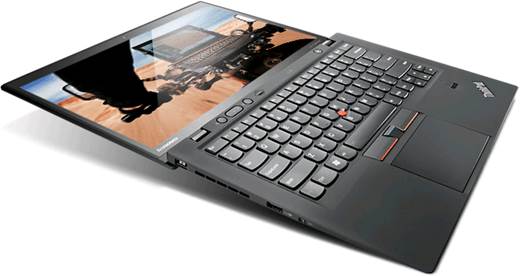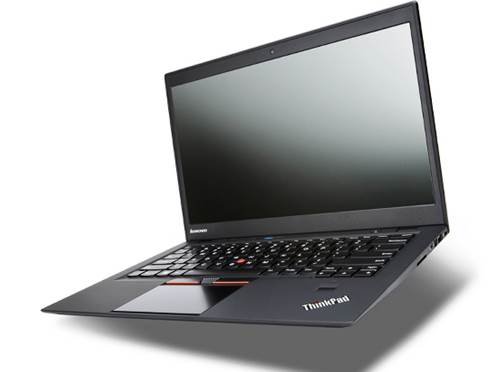When Lenovo launched the ThinkPad X1 Carbon,
it seemed like the kind of thing ThinkPad fans had been waiting for: an
ultraportable with fast performance, a vibrant 1,600x900 screen and, of course,
one well-designed keyboard. In fact, we consider it one of our favorite
Ultrabooks - not just for businesspeople, but for everyone.
The problem is that it arrived just before
Windows 8 was on sale, which means four months after its release, it's already quite
outdated. Check out the ThinkPad X1 Carbon Touch: it's more or less alike the
X1 Carbon you know and love, except for the fact that it has a touchscreen
allowing finger input. (Don't worry, that special red pointing stick hasn't
gone anywhere). So, basically, is this just a better version of the original X1
Carbon? And is it worth the “enormous” 1,499 USD starting price (250 USD higher
than the non-touch version)? Let's find out.
Design and feel
There's also a reason for this to be called
X1 Carbon: it has the same look and feel as its predecessor, with a black, smooth
cover, slightly rounded edges and a simple layout including very few openings or
vents. It's equally durable, too, with a rock-solid palm rest and a display
that doesn’t shake or shimmy. The lid latch is still there although it's easy
to open. In brief, it looks exactly the way you'd expect from a ThinkPad:
monotone and discreet, with clean lines and angular shapes. Perhaps, it’s
smaller in appearance than that of the old T410 you have somewhere in your home
office.

Lenovo
Thinkpad Carbon Touch Ultrabook
The main difference here is that Carbon's
chassis isn't impressively thin or light as it was in the first time - a
necessary concession when touchscreens are included. The result of that touch screen
is that the wedge-shaped body now having the size of 0.74 inch at the thicket
point, up from 0.71 inch. Naturally, too, it's also heavier: 3.4 pounds, compared
to 3 pounds of the non-touch model.
But before we start obsessing about 1/10 of
a pound, let's think of a little perspective here: we've seen 13-inch
Ultrabooks that weigh more than this, so it's very impressive to find a 14-inch
laptop at this lightweight. (To compare, the 14-inch HP EliteBook Folio
business Ultrabook weighs 3.6 pounds.) Besides, the X1 Carbon-series laptops
are of the small types with 14-inch laptops, as they have thin bezels that make
it possible to cram a 14-inch screen into a chassis normally reserved for
13-inch machines. In fact, we've seen this technique used before, but it's
still pretty rare. Basically, if you're looking for something with a big screen
and a frame this light, your choices have already shrunk.
We have mentioned that the X1 Carbon Touch is
less in vents and grills, but it still has several physical buttons, most of
them located just above the keyboard. Beside the power button, they include
keys for muting the volume or just silencing the mic, in cases you're having a
VoIP call. There's also a volume rocker there although all the other multimedia
controls (skip, pause, etc.) are pre-installed into the Function keys at the
top of the keyboard. In addition, there's a fingerprint reader on the wrist
rest and an on/off switch on the left edge to put the machine into airplane
mode (you won't want to make the plane crash, will you?).

We
have mentioned that the X1 Carbon Touch is less in vents and grills, but it
still has several physical buttons, most of them located just above the
keyboard.
Aside from that, the port selection is quite
modest, but it still has most of your necessary things. Inside, you have two
USB sockets (2.0 and 3.0), a headphone / mic jack, a Mini DisplayPort, a lock
slot and a 4-in-1 memory card reader. The charging port, positioned on the
back-left edge, is in rectangular shape, similar to a USB port, but we're just
adding it for interest: after all, we're used to proprietary charging device on
laptop.
Keyboard and trackpad
We have to say one thing: if you're a
ThinkPad supporter who always wants to buy another ThinkPad, it's probably
because of the excellent typing experience (or the design quality, but make us
laugh here). This is the same water-resistant, six-row keyboard that you'll
find on other new ThinkPads, along with "Smile" keys in U-shape. Aside
from that, this is a chiclet-style setup (a significant deviation as compared
to the older ThinkPad keyboard), the big difference here is that the keys has
30-percent more surface area than on the older layout. In fact, especially on a
ThinkPad with bigger screen like this, the buttons feel well-spaced - so you'll
never have the risk of hitting mistakenly the wrong key. The only exception may
be the left Ctrl key, which has been shrunken to fit the 13-inch-wide keyboard tray.
In fact, we ever missed it, but it can still be hard to find when you're trying
to use standard keyboard shortcuts.

This
is the same water-resistant, six-row keyboard that you'll find on other new
ThinkPads, along with "Smile" keys in U-shape.
If you're planning on upgrading from an
older ThinkPad, you can be comfortable in this: Lenovo proclaims that although
the keys are now arranged in a chiclet style, the actual typing experience won't
feel much different from typing on the old layout. We know some ThinkPad fans who
swear that's untrue but. Regardless of whether this is actually like the old
ThinkPad keyboard, the new one delivers feedback that's great powerful, even.
It is still one of our favorite laptop keyboards, and it's definitely a better
typing experience than what you'll receive on other Ultrabooks, most of which relate
to shallow, lifeless keys.
One last thing: the keyboard is back lit,
which is untrue to all ThinkPad.
The red pointing stick is the same thing
you'll find on other new ThinkPad systems. Though other companies like HP
include something similar on their business laptop line, Lenovo's version is
still our favorite: thanks to a fine pattern of exposed dots on top, you can
comfortably put your finger there without worrying about being slipping off. In
fact, though the pointing stick may be unfamiliar to those who don't use
ThinkPads, we actually prefer it to the traditional touchpad.
The wide glass trackpad is another good replacement
for constantly using your fingers. It has a slightly rubbery cover, which adds
just a bit of resistance when you swipe in from the sides and drag your pointing
finger around. In general, that little bit of friction is a good thing: it
makes everything from simple pointer navigation to two-finger scrolling feel
more controlled. Namely, this doesn't mean there isn't room for refining: sometime
it mistakes regular single-finger navigation for a different kind of gesture:
that’s when you swipe in from the top or bottom of the trackpad to expose app
settings.